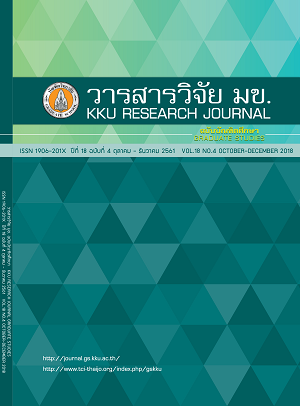Optimization of Decolorization (Somnauk’s Red Dye No. 9) Using Fenton-Like Reaction Over Iron Powder by Box-Behnken Design (BBD)
Keywords:
Fenton-Like reaction, Degradation of dye, Iron-powderAbstract
The objective of this study was to find the optimal condition for Somnauk’s red dye No. 9 (SR09) decolorization using Fenton-like process. The experiments were performed in a batch reactor. A set of experiment was designed using Box–Behnken design (BBD) and the response surface analysis was used to optimize for the maximum decolorization efficiency. An initial pH of solution, an amount of iron-powder, and an initial H2O2 dose were selected to be the independent variables while decolorization efficiency was considered as the response of functions. The initial concentration of SR09, and the reaction time were kept constant of 100 ppm and 2 hour, respectively. It was found that decolorization efficiency increased with an increasing of H2O2 dose and a catalyst loading however it decreased when the H2O2 dose and catalyst loading were up to a certain level. High concentrations of iron-powder and high H2O2 dose adversely affected to the decolorization efficiency due to both of them were acting as hydroxyl radical scavenging. The results were agreed well with a quadratic model (R2= 0.985). The optimal pH, catalyst loading, and H2O2 dose were found to be 3, 0.464 g/L, and 45.5 mM, respectively, and the 96±0.53% removal efficiency was achieved. Decolorization efficiency through iron-powder/H2O2 process was not decreased significantly even after 5 successive cycles, moreover, it was found that leached iron and TOC (Total organic carbon) were less than 2 ppm and 10 mg/L in each batch respectively. The wastewater after treatment is compliance with the Thailand-industrial estate water discharging standard.
References
2. Lucas MS, Peres JA. Decolorization of the azo dye Reactive Black 5 by Fenton and photo-Fenton oxidation. Dyes and Pigments. 2006;71(3):236-244.
3. Kasiri MB, Khataee AR. Photooxidative decolorization of two organic dyes with different chemical structures by * UV/H2O2 process: Experimental design. Desalination. 2011;270(1–3):151-159.
4. Idel-aouad R, Valiente M, Yaacoubi A, Tanouti B, López-Mesas M. Rapid decolourization and mineralization of * the azo dye C.I. Acid Red 14 by heterogeneous Fenton reaction. Journal of Hazardous Materials. 2011;186(1):745-750.
5. Duygu Ozsoy H, van Leeuwen J. Removal of color from fruit candy waste by activated carbon adsorption. Journal * of Food Engineering. 2010;101(1):106-112.
6. Constapel M, Schellenträger M, Marzinkowski JM, Gäb S. Degradation of reactive dyes in wastewater from the * textile industry by ozone: Analysis of the products by accurate masses. Water Research. 2009;43(3):733-743.
7. Khan SB, Hou M, Shuang S, Zhang Z. Morphological influence of TiO2 nanostructures (nanozigzag, nanohelics * and nanorod) on photocatalytic degradation of organic dyes. Applied Surface Science. 2017;400:184-193.
8. Thonglim K, Chiarakorn SPP. Photocatalytic Reaction of Light Filter Film Coated by Silver Doped Titania. * KKU Res J. 2015;15(2):48-55. Thai.
9. Srimuang KKK. Efficiency of Dye Adsorption From Silk Dyeing Wastewater by Ferricchloride Coated With * Bituminous Bottom Ash. KKU Res J. 2017;17(3):53-63. Thai.
10. Panda N, Sahoo H, Mohapatra S. Decolourization of Methyl Orange using Fenton-like mesoporous Fe2O3–SiO2 * composite. Journal of Hazardous Materials. 2011;185(1):359-365.
11. Devi LG, Raju KSA, Kumar SG, Rajashekhar KE. Photo-degradation of di azo dye Bismarck Brown by advanced photo-Fenton process: Influence of inorganic anions and evaluation of recycling efficiency of iron powder. Journal of the Taiwan Institute of Chemical Engineers. 2011;42(2):341-349.
12. Khataee A, Salahpour F, Fathinia M, Seyyedi B, Vahid B. Iron rich laterite soil with mesoporous structure for * heterogeneous Fenton-like degradation of an azo dye under visible light. Journal of Industrial and Engineering * Chemistry. 2015;26:129-135.
13. Srerungruang N, Neramittagapong A, Sriprom P, Kumsaen T, Sangnak SSN. Optimization of Back-Washing Condition for Centrifugal Extractor to Minimize Cassava Starch Loss. KKU Res J. 2017;17(2): 61-70. Thai.
14. Nasuha N, Ismail S, Hameed BH. Activated electric arc furnace slag as an efficient and reusable heterogeneous Fenton-like catalyst for the degradation of Reactive Black 5. Journal of the Taiwan Institute of Chemical Engineers. 2016;67:235-243.
15. Fida H, Zhang G, Guo S, Naeem A. Heterogeneous Fenton degradation of organic dyes in batch and fixed bed using La-Fe montmorillonite as catalyst. Journal of Colloid and Interface Science. 2017;490:859-868.
16. Suthep S, Veeranuch B. Organic Compounds and Color R e m o v a l b y F e n t o n a n d Coagulation Processes in Textile Wastewater. Kasetsart Engineering Journal. 2010;72:10-16.
17. Song H, Chen C, Zhang H, Huang J. Rapid decolorization of dyes in heterogeneous Fenton-like oxidation catalyzed by Fe-incorporated Ti-HMS molecular sieves. Journal of Environmental Chemical Engineering. 2016;4(1):460-467.



